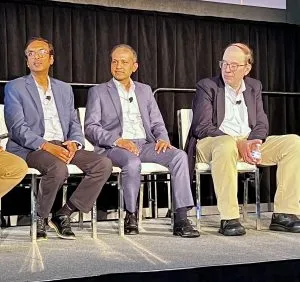
Saverio Fazzari, senior lead engineer at management consultancy Booz Allen Hamilton. Workforce development, expressed his hopes for the cash injections. “Too often, US-based companies are opening centres overseas to facilitate innovation. My hope and belief is that the Chips Act can change that [and] they can open those centres in the US [to] enable that innovation in the US.”
He cited anecedotal rises in the number of students in colleges and taking Masters or PhD programmes for design related activites and an increase in the numbers looking for related jobs in the US. “Today, you see commercial companies hiring within the US because of patent laws,” he said. The thinking is ‘If I build the design in the US I can protect it better’. I see it [but] can I measure it at this point? No,” he added.
For Nilesh Kamdar, general manager, deign and verification at Keysight, the workforce is key. “I agree, we are seeing some green shoots,” he said agreeing on the increase in student numbers both in US universities and working on projects. He balanced this with the number of engineers that are retiring and leaving the industry. The loss to the IC semiconductor design, he described as “quite high”. Covid may have accelerated the rates of retirement, with people deciding, for many reasons, to take early retirement, creating a “fairly big gap” in the workforce, he said.
What the Chips Act is doing is positive, he said, “but we need to do more, using government investment and putting a spotlight on this issue.
“Look at Silicon Valley, there is no shortage of money if you are doing an AI startup, or if you are building the next challenge to OpenAI, you can raise $1bn but the government is probably the last bank standing for semiconductor and design and IT”.
Vivek Prasad, vice president of Design Engineering Ecosystem Enablement at Natcast, urged for a broader view of where young talent and manufacturing should take place. He said that manufacturing was leaving the US because of cost pressures and the talent was also emigrating. He advocated workforce initiatives. “If we build the talent here we should be able to keep some of the innovation inhouse but we also need to move away from centres like Silicon Valley and Boston and such and expand where inovation can happen in the US, where the cost will be better managed.”
Fazzari agreed that new locations are vital. He was also confident that the fate of the industry need not rest exclusively in the hands of the governement funding – there are other revenue sources available, he argued. What is done with capital raised is key. “It is a question of can the community use [the money] as the match to start the fire to go down a new path,” he said. “Natcast came out of commercial industry, pushing the government to make this happen. How do you keep pushing forward to have the diferent touchpoints, like the power grid and other areas where you need design as innovation?
“I don’t see in the current administation and environment that you are going to see X number [of companies] drop into this space when they are seeing foreigh companies investing $100bn into the US. It just needs to be a collective that goes after this [investment] in a way that says ‘We are ready and we’re going to be aggressive’ “.
Pictured from left to right: Nilesh Kamdar, Keysight, Vivek Prasad Natcast, Saverio Fazzari, Booz Allen Hamilton
Related:
